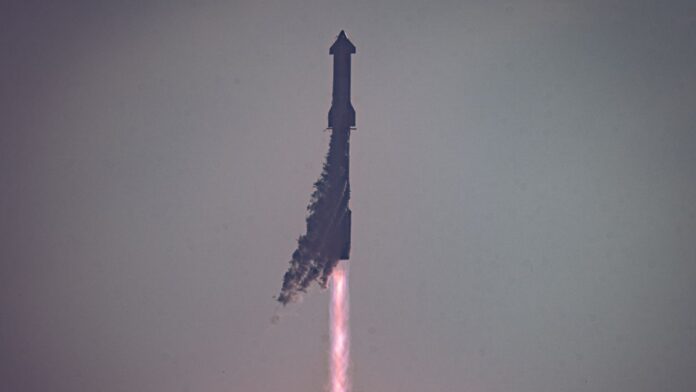A coalition of environmental groups is suing the U.S. Federal Aviation Administration (FAA), claiming the agency didn’t fully analyze the environmental damage that SpaceX’s huge Starship vehicle could cause to sensitive lands.
The FAA cleared SpaceX to conduct 20 launches of Starship each year for the next five years, notes the lawsuit, which was filed today (May 1) in federal district court in Washington, D.C.
The first of those permitted launches occurred on April 20 from Starbase, SpaceX’s site on South Texas’ Gulf Coast near Boca Chica Beach. The 394-foot-tall (120 meters) Starship — the biggest and most powerful rocket ever built — performed well on the test flight initially and managed to reach a maximum altitude of 24 miles (39 kilometers). But the giant spacecraft suffered several issues that forced SpaceX to command the vehicle’s destruction high over the Gulf of Mexico.
Related: Relive SpaceX’s explosive 1st Starship test in incredible launch photos
The explosive test mission sent particulate matter raining down on the surrounding area, notes the lawsuit, which was filed by the Center for Biological Diversity, the American Bird Conservancy, the Surfrider Foundation, Save RGV and the Carrizo/Comecrudo Nation of Texas.
That’s less than ideal, given the environmental importance of the area, the organizations stress.
“SpaceX’s Boca Chica launch site is surrounded by state parks, National Wildlife Refuge lands and important habitat for imperiled wildlife, including piping plovers, northern aplomado falcons, Gulf Coast jaguarundi, ocelots and critically endangered sea turtles,” the Center for Biological Diversity wrote in a statement today (opens in new tab).
“Rocket launches and explosions cause significant harm through increased vehicle traffic and the intense heat, noise, and light pollution from construction and launch activities,” the Arizona-based nonprofit added. “Rocket explosions spread debris across surrounding habitat and have caused brush fires.”
The FAA is investigating the launch mishap with SpaceX.
Video: Every SpaceX Starship explosion and what we learned from them
SpaceX’s work at Starbase also affects people in the area, according to the lawsuit. For example, Boca Chica Beach is public, but the FAA permit allows SpaceX to close access to it for up to 800 hours per year.
Such closures are a hardship for the native Carrizo/Comecrudo people, affecting their ability to hold ceremonies in the area, the lawsuit states.
“The Carrizo/Comecrudo people’s sacred lands are once again being threatened by imperialist policies that treat our cultural heritage as less valuable than corporate interests,” Juan Mancias, tribal chair of the Carrizo/Comecrudo Nation of Texas, Inc., said in the same statement.
“Boca Chica is central to our creation story,” Mancias added. “But we have been cut off from the land our ancestors lived on for thousands of years due to SpaceX, which is using our ancestral lands as a sacrifice zone for its rockets.”
The lawsuit, which you can read here (opens in new tab), calls on the FAA to conduct a full environmental review of SpaceX’s Starship activities in South Texas. (The agency previously required SpaceX to perform more than 75 “mitigating” actions but did not mandate a more stringent environmental impact statement (opens in new tab).)
“It’s vital that we protect life on Earth even as we look to the stars in this modern era of spaceflight,” Jared Margolis, a senior attorney at the Center for Biological Diversity, said in the same statement. “Federal officials should defend vulnerable wildlife and frontline communities, not give a pass to corporate interests that want to use treasured coastal landscapes as a dumping ground for space waste.”
The stainless-steel Starship consists of a first-stage booster called Super Heavy and a 165-foot-tall (50 meters) upper-stage spacecraft known as Starship. Both elements are designed to be fully and rapidly reusable, a breakthrough that SpaceX founder and CEO Elon Musk thinks will make Mars colonization — his long-held dream — economically feasible.
Both Starship and Super Heavy are powered by SpaceX’s next-gen Raptor engine, 33 for the booster and six for the upper-stage spacecraft. Super Heavy can produce 16.7 million pounds of thrust at liftoff, according to the company — nearly twice as much as NASA’s Space Launch System megarocket, the most powerful rocket ever to fly a successful space mission.
The April 20 test flight caused considerable damage to Starbase’s orbital launch mount. But the site should be repaired and ready to support another Starship launch in one to two months, Musk has said.
Mike Wall is the author of “Out There (opens in new tab)” (Grand Central Publishing, 2018; illustrated by Karl Tate), a book about the search for alien life. Follow him on Twitter @michaeldwall (opens in new tab). Follow us on Twitter @Spacedotcom (opens in new tab) or Facebook (opens in new tab).

